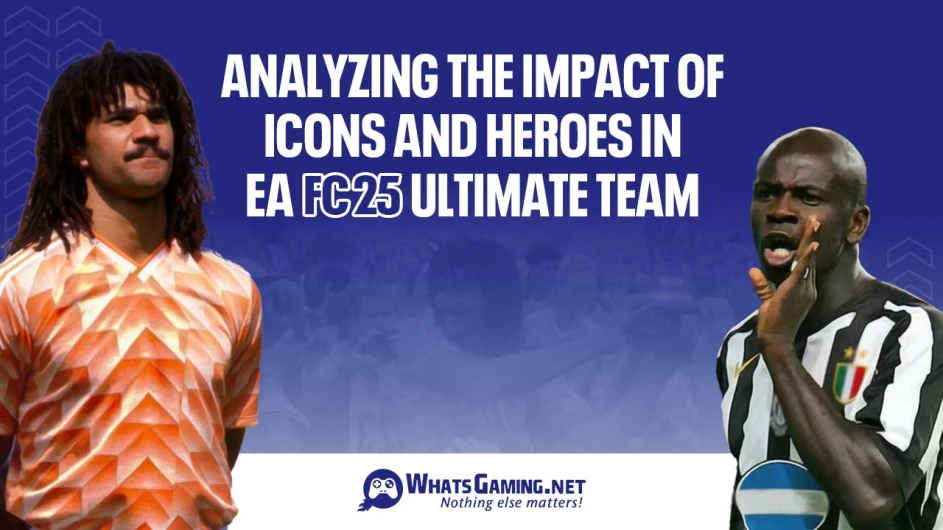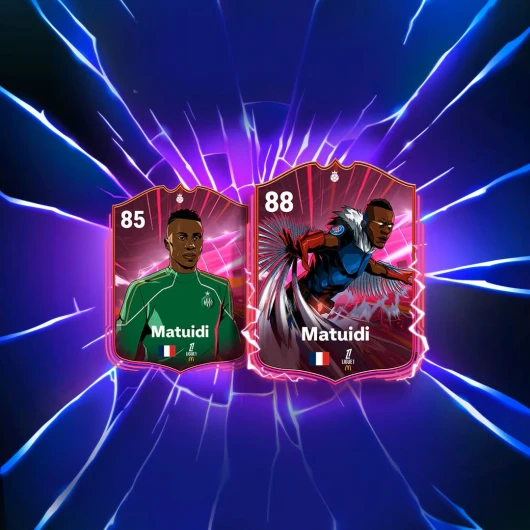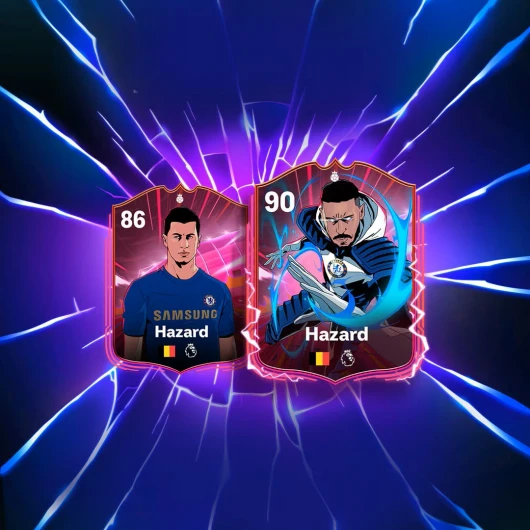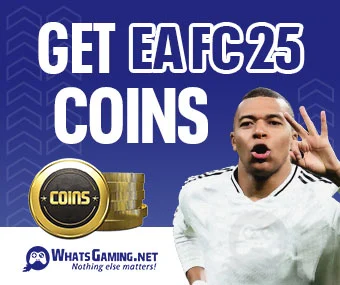
Analyzing the Impact of Icons and Heroes in EA SPORTS FC 25 Ultimate Team
If there’s one thing that keeps FIFA (now EA SPORTS FC) players coming back year after year, it’s the tantalizing dream of building the ultimate squad. While the mechanics and branding might shift, the heart of Ultimate Team stays the same: assembling a lineup that strikes fear into your opponents—and maybe, just maybe, makes you feel a bit like a footballing god. In EA SPORTS FC 25, that dream is more alive than ever thanks to the continued dominance of two key card types: Icons and Heroes.
These legendary additions aren’t just shiny collector’s items. They’re powerful tools, sentimental throwbacks, market-shaking assets, and—depending on your pack luck or wallet size—either game-changers or eternal sources of envy. In this piece, we’ll dig deep into how Icons and Heroes continue to shape the Ultimate Team experience in FC 25, from chemistry systems to FUT economy, and even the emotional connection players have with their favorite footballing legends.
![]()
What Are Icons and Heroes? A Quick Refresher
Before we get deep into tactics and market trends, let’s clear the air for any newer players or those who haven’t yet dipped into the golden glow of an Icon pack. Icons are legendary footballers whose influence transcends generations—think Pele, Zidane, Ronaldinho, and more. They represent the highest echelon of football history, and in Ultimate Team, they’re designed to be elite performers capable of fitting into almost any squad, regardless of nationality or league.
Heroes, on the other hand, are a more recent addition to the game’s pantheon. They celebrate cult figures and unforgettable moments from football’s rich tapestry—players like Yaya Touré, Dirk Kuyt, or Antonio Di Natale. While they might not be as universally dominant as Icons, they come with their own unique chemistry benefits and are often more accessible, making them favorites among more casual or budget-conscious FUT players.
Together, Icons and Heroes inject a nostalgic flair into a game that’s often hyper-focused on current stats and live updates. They bridge the past and the present, creating the ultimate football fantasy: a team where Kylian Mbappé feeds through balls to Prime R9, while a Hero like Jay-Jay Okocha dances past defenders in midfield.
Gameplay Impact: Chemistry, Meta, and Squad Building
Icons and Heroes aren’t just aesthetic bonuses—they're built to be impactful. In FC 25, the chemistry system has undergone more refinements, and both Icons and Heroes benefit immensely. Icons continue to act as universal links, fitting neatly into squads regardless of league, which makes them incredibly useful for hybrid builds. Need to link a Ligue 1 winger with a Premier League striker? Toss in a mid-tier Icon in midfield and watch those chemistry lines light up.
Heroes offer a more targeted advantage. They provide strong chemistry to players from the same league and nation, which can be a game-changer for players building league-based teams. Their unique chemistry boosts make them valuable tactical pieces—especially in tight squad-building challenges or competitive play where every advantage counts.
In terms of gameplay, many Icons and Heroes sit right at the top of the current meta. Whether it’s the raw finishing of Icon-level strikers or the tactical awareness of a Hero midfielder, these cards can make a huge difference in tight matches. Even for high-level FUT Champs players, squeezing an Icon or Hero into the starting XI often isn’t a luxury—it’s a necessity.
![]()
Market Influence: The Ripple Effect on the FUT Economy
When it comes to the FUT market, few cards stir the pot like Icons and Heroes. They’re the crown jewels of the transfer market, commanding high prices and creating wild fluctuations depending on the game's current meta or a new SBC (Squad Building Challenge) drop. When a desirable Icon becomes part of an SBC, market trends shift instantly—certain fodder cards skyrocket, and demand for other Icons can shoot through the roof.
The availability of Icons and Heroes also heavily impacts how players value their coins. Rather than investing in five decent players, some will save up to get one game-changing Icon. This causes an interesting ripple effect where middle-tier players see less demand while high-end legends absorb a massive portion of the market’s wealth.
Moreover, the rarity of pack-pulled Icons and Heroes continues to spark debates about FUT's monetization model. The promise of packing a Cruyff or a Hero Fernando Morientes keeps players opening packs—often with real-world money. This economic ecosystem, while thrilling, also fuels the ongoing conversation about fairness, accessibility, and the influence of spending in competitive modes.
Emotional & Cultural Weight: Nostalgia Meets Gameplay
Beyond raw stats and market influence, Icons and Heroes carry something no gold-rated 87 striker ever could—emotional resonance. For many fans, these cards are direct connections to childhood memories, classic matches, or unforgettable goals. Seeing a player like Alessandro Del Piero or David Beckham back on the virtual pitch taps into deep-rooted football nostalgia.
This emotional power isn’t just a gimmick. It enhances the overall FUT experience. Recreating moments with your favorite club legend or scoring a Champions League-style goal with a Hero tied to that memory adds layers of joy that go beyond leaderboard rankings. These cards make the game more personal, more storied, and frankly, more fun.
And culturally, the inclusion of more globally diverse Icons and Heroes has started to broaden FUT’s appeal even further. With each new edition, EA taps into different footballing regions, bringing in beloved names from Asia, Africa, South America, and beyond. It’s a smart move that celebrates the global nature of the sport while making more players feel seen and represented.
Power Curve & Balance: Are They Too Strong?
Of course, any discussion about Icons and Heroes wouldn’t be complete without addressing the balance issue. These cards can be overpowered—sometimes to a frustrating degree. A Prime Icon can often outperform top-tier current players with ease, leading to an unbalanced experience for players who can’t afford them or didn’t get lucky in packs.
EA has tried to balance things by staggering Icon releases—Base, Mid, Prime, and Moments versions—and by making some Heroes less meta-relevant. But in practice, the power gap still exists. Players with stacked squads of Icons and Heroes tend to have a significant edge, particularly in weekend league and high-tier Rivals matches.
This creates a sort of FUT caste system where your chances of success are directly tied to your ability to acquire these elite cards. It’s a balancing act that EA continues to tweak, but as long as Icons and Heroes remain at the top of the food chain, there’ll always be discussions around fairness and accessibility.

EA’s Strategy: Content Kings or Pay-to-Win Bait?
Let’s not kid ourselves EA knows exactly what it’s doing with Icons and Heroes. These cards are more than just gameplay additions; they’re part of a well-oiled content machine. Every time a new Icon SBC drops or a fresh Hero is leaked, social media lights up, the in-game market surges, and player engagement skyrockets. It’s brilliant from a business perspective, but it walks a fine line between fun content and cash grab.
Some players see Icons and Heroes as the ultimate form of “pay-to-win.” The best versions are often locked behind expensive packs or borderline absurd SBC requirements. This makes them accessible mostly to hardcore players or those willing to drop real money. Meanwhile, casual players might only experience these legends via loan cards—brief teases of what could be.
That said, EA has made some attempts to democratize access in FC 25. There have been more grindable objectives, repeatable SBCs, and occasional Icon picks through seasonal rewards. But even then, the path is long, and the RNG gods must smile upon you. It’s a system that constantly dances between generosity and monetization, and EA’s choices around these cards will always reflect the ongoing tension between fairness and profit.
The Fun Factor: Recreating Fantasy Football Moments
For all the meta talk and FUT economy analysis, there’s one thing that makes Icons and Heroes stand out more than anything else: they’re just fun. There’s something undeniably special about lining up with a squad that includes Ronaldinho pulling elasticos on the wing, or Park Ji-sung bossing the midfield. It’s like a footballing multiverse where dreams become reality.
These cards allow players to relive iconic moments or create new ones. Want to imagine a frontline of Messi, Mbappé, and Prime Thierry Henry? Go for it. Feel like testing how modern defenders would handle a peak George Best? Have at it. This kind of imagination-fueled gameplay is at the heart of what makes Ultimate Team so addictive—and it’s one of the few features that truly separates FC from other sports games.
What’s more, the introduction of PlayStyles+ and position versatility in FC 25 adds more layers to the experience. Now, Icons and Heroes feel even more tailored to their real-life styles. It’s no longer just about pace and shot power—it’s about playmaking IQ, dribbling flair, and those intangible footballing instincts that made these players great in the first place.

What’s New in FC 25: Evolving the Legends
One of the biggest shifts in EA SPORTS FC 25 has been how Icons and Heroes are integrated into the evolving meta. From what we’ve seen so far, EA has added more dynamic chemistry effects and introduced new tiers of Hero cards—like Hero Evolution or special league-themed Heroes that boost team synergy even further. These additions shake up the way players view squad building and bring fresh life to old favorites.
There’s also been more regional diversity in the new Icons introduced this year. Players from lesser-represented footballing nations have finally gotten their spotlight, offering more team-building creativity and cultural representation. It’s a subtle yet important change that keeps Ultimate Team feeling inclusive and global.
And let’s not forget about the rumored introduction of Era Icons—cards that reflect specific phases of a player’s career (e.g., early vs. prime vs. twilight years). If confirmed, this could take the concept of Icons to a whole new level, giving players more control over what version of their favorite legends they want to build around.
Conclusion: Are Icons and Heroes Still Worth It?
As FC 25 continues to evolve, one thing remains clear: Icons and Heroes aren’t going anywhere. They’re more than just high-rated cards—they’re the heart of the fantasy that drives Ultimate Team. Whether you’re a hardcore grinder, a casual weekend warrior, or a nostalgic fan chasing childhood heroes, these cards offer something uniquely personal in a game that often feels like a numbers race.
Sure, there are valid criticisms around balance, accessibility, and monetization. But despite the flaws, Icons and Heroes remain one of the most beloved parts of the Ultimate Team experience. They turn squads into stories and highlight reels into history lessons. And in a mode as competitive as FUT, sometimes that little touch of magic—or memory—is what makes all the difference.
So yes, they’re worth it. Not just for the stats, or the wins, but for the moments you’ll remember—when you curved in a 30-yarder with Roberto Carlos, or pulled off a last-minute comeback with a clutch goal from Diego Forlán. That’s what makes Ultimate Team feel truly ultimate.
We will share more updates on FC 25 in separate articles. If you found this information helpful or would like to learn more, please be sure to explore the other articles on our site.
Essential Tips for Competing in Division Rivals and FUT Champions in EA SPORTS FC 25



